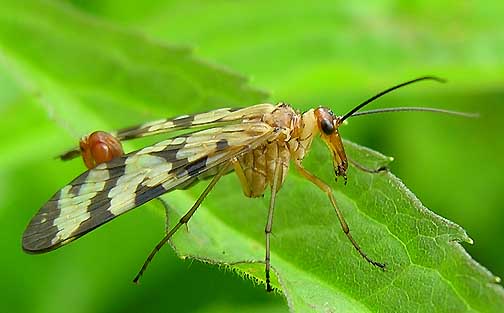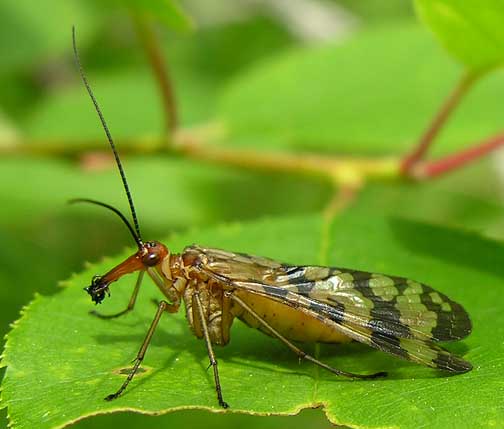June 25th, 2006
he and she
For about three weeks, I’ve been finding Scorpionflies here at the farm and at other sites which I frequent. I suppose that these small insects fall into almost the same category as the Mantidflies which I wrote about a few days ago — composed of parts that look as though they came from several different creatures. Their wings look a bit like those of a Deer fly, being heavily patterned. However, Scorpionflies are not flies at all, actually having four membranous wings instead of the fly’s two wings. They have elongated heads which, in my opinion, give them the look of a rather homely horse or mule. But most conspicuous of all, is the feature that gives them their name — the males possess a long curling tail that ends in a bulb that looks rather like the stinger of a Scorpion (see above – click on image for larger view). However, the appendage is actually the male’s genitalia. Females lack this feature, their tails being long and straight and ending in a simple point (see image below — tail is held down flat and hidden beneath the female’s wings). Based on observation of both male and female insects, the females seem to be somewhat larger than the males.
Although few people seem to have seen these insects, I encounter them frequently. Perhaps it’s that I spend time in places that provide ideal habitat, or maybe I’m just used to watching for them. From my own experience, they are usually found in partial shade, resting on vegetation or tree leaves in the dappled light of a forest edge, their mottled wings providing some camouflage. I frequently find them munching on tiny insects, as in the example below. When disturbed, they will usually move to a nearby leaf. They don’t seem particularly nervous and I can often hold and steady the leaf they are perched on while I’m shooting photos. Despite the vaguely menacing appearance of the male’s tail, they don’t bite or sting.
I did a bit of checking around on the net to see if there were any factoids about Scorpionflies that might be of interest Surprisingly, there doesn’t seem to be a great deal written about them on the net. However, I did come across one interesting tidbit on a page describing the Scorpionfly logo selected for the 55th annual meeting of the North Central Branch of the Entomological Society of America back in 2000. In the description of the insect, it states: “They are noted for their complex mating systems where males court females with dead prey. The males with the best nuptial gifts get the most mates. Males sometimes pose as females to grab their rivals dead insect and improve their chances!” I guess this factoid will fulfill my must-learn-at-least-one-new-thing-each-day requirement for today. I can’t say that I’ve ever seen this food-offering behaviour in the past, but now I shall have to watch for it.
Tags: Scorpionfly, Panorpa, Mecoptera


June 25th, 2006 at 5:03 pm
WOW! Such cool lookin insects…I’m making a list of all species I find in my garden also spiders itis fun.
June 25th, 2006 at 6:42 pm
What incredible creatures and what stunning photos. Plus the interesting text. Excellent blog!
June 26th, 2006 at 9:58 am
I was away from the computer for about a week and am having a hard time finding the time to catch up. I was pleased to skim read about six of your recent blogs this morning. Have you considered collecting your blog writing for a book? It would be wonderful!
June 26th, 2006 at 11:15 am
Jimmy — I think that’s a great idea to keep a species list or even a photo gallery of insects and spiders found in your garden. It’s a super way to get a feel for the ecology of a certain place.
–
Green Poet – Thanks for your comments, and also for dropping by to read my blog!
–
O.W. – Thanks. I hadn’t really been thinking about doing anything in particularl with my blog posts, but a couple of friends have recently mentioned that they are almost like magaze articles or chapters from a book. Maybe they’ve got a point! It’s something to think about.
June 7th, 2007 at 10:01 am
[…] If you’ve been reading my blog for awhile, you’ll probably remember a post about Scorpionflies from last summer. Yesterday, while checking the foliage along the trails, I saw more Scorpionflies than the combined total I’ve seen in my life. It was just amazing. In a couple of patched of goldenrod and other plants shaded by trees, I could look around and see a half dozen males at a time, perched on leaves just a few inches below the surface. They were so inactive that I could easily turn a leaf from side to side, photographing them from different angles without them twitching so much as a wing. Needless to say, I shot quite a number of photos. I won’t write about their natural history today, but if you’re interested, read my older post linked to above. They’re fascinating little insects. […]
June 7th, 2007 at 6:39 pm
Wonderful introduction to an obscure group of insects, Bev, and your photos are admirable! I’ll keep an eye out for scorpionflys; as Thoreau, said (I paraphrase): You only see what you are prepared to see.
June 8th, 2007 at 6:34 am
Larry – Thanks! Yes, watch for scorpionflies as I think they can be found just about everywhere in North America — and yup, Thoreau was quite right about “seeing”.